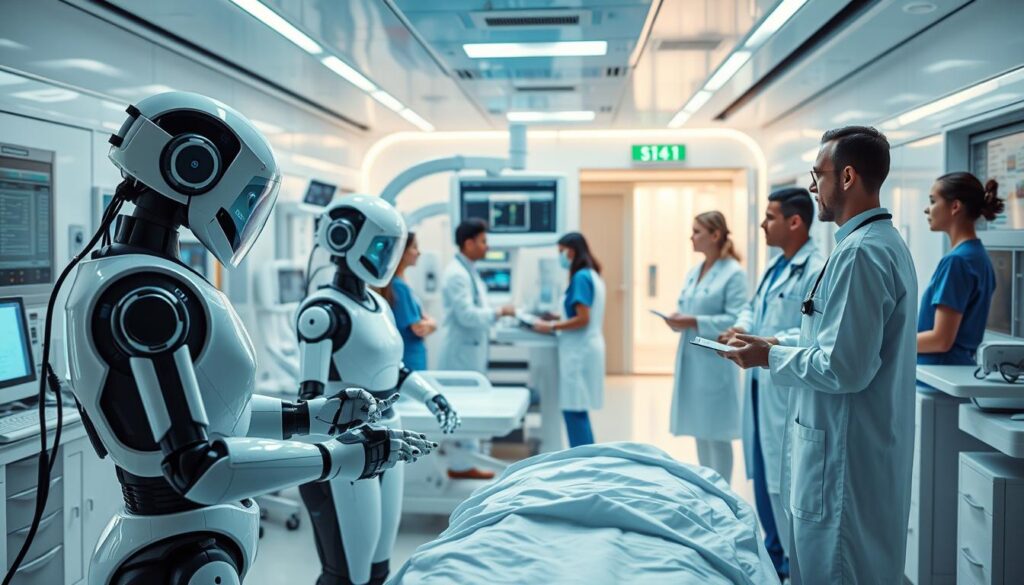Automation is changing our world fast. The future looks even more exciting. We’ll see more intelligent machines, thanks to AI, and the rise of robotics and smart manufacturing. This article will explore how these technologies will change industries, workplaces, and our daily lives.
We’re entering an era where machines are smarter than ever. AI, machine learning, and other technologies are making machines learn and adapt quickly. This is a big change for many sectors.
Robotics and autonomous systems are leading this change. They make processes faster and cheaper. They’re changing healthcare and manufacturing in big ways. AI and robotics together are creating a new era of smart manufacturing, known as Industry 4.0.
But, there are big questions about the future of automation. How will it affect jobs and the workforce? We’ll need to learn new skills to keep up with these changes.
Let’s look at what’s coming next in automation. We’ll talk about quantum computing and neuromorphic computing. These advancements will open up new possibilities for our world.
Key Takeaways
- The future of automation is driven by the rise of intelligent machines, AI, robotics, and smart manufacturing.
- AI technologies like machine learning, deep learning, natural language processing, and computer vision are transforming industries and workplaces.
- Robotics and autonomous systems are streamlining processes, reducing costs, and revolutionizing sectors like healthcare and manufacturing.
- The integration of AI and robotics is ushering in the era of Industry 4.0, optimizing production and supply chains.
- The future of automation must address ethical considerations and the impact on employment, requiring reskilling and upskilling of the workforce.
Unveiling the Boundless Potential of Automation
We are in an era where smart machines and automation are changing industries and workspaces. The future of automation is vast, as these advancements keep changing how we work and live.
The Era of Intelligent Machines
Machines are getting smarter, able to do many tasks with great precision and speed. They are being used in areas like manufacturing, healthcare, transportation, and logistics. This is making processes smoother, boosting productivity, and improving performance.
This change is bringing us into a new era of intelligent machines. These machines are pushing the limits of what’s possible.
Transforming Industries and Workplaces
Automation’s impact is seen in many industries, as companies use these technologies to stay ahead. Automated systems are making workflows better, cutting down on mistakes, and improving product and service quality. In workplaces, automation lets employees do more important tasks, making jobs more satisfying and work more efficient.
Looking ahead, the future of automation is limitless. The mix of intelligent machines and automation is leading to a big change in industries and workspaces. It’s creating a place where human skills and machine abilities work together perfectly.
“Automation is not just about efficiency; it’s about unlocking human potential and redefining the way we work.”
Artificial Intelligence: The Driving Force
Artificial intelligence (AI) is at the core of the automation future. It’s changing how machines work, making them key in many fields. AI lets machines handle complex tasks, making them essential in different industries.
Machine Learning and Deep Learning
Machine learning and deep learning are big in AI. They let machines learn and get better on their own. These AI tools help machines spot patterns, predict things, and get smarter over time.
They’re changing how we use technology. From recognizing images to understanding language, AI is making a big impact.
Natural Language Processing and Computer Vision
AI is also driving progress in natural language processing (NLP) and computer vision. NLP lets machines understand and create human language. Computer vision lets them see and analyze pictures.
These skills are key for automating tasks. They help with customer service, medical diagnosis, and self-driving cars.
| Technology | Application | Impact |
|---|---|---|
| Machine Learning | Image recognition, predictive analytics | Improved accuracy, efficiency, and decision-making |
| Deep Learning | Natural language processing, speech recognition | Enhanced human-machine interaction and automation |
| Computer Vision | Autonomous vehicles, medical imaging analysis | Increased safety, precision, and accessibility |
| Natural Language Processing | Chatbots, language translation, sentiment analysis | Streamlined communication and personalized experiences |
These AI technologies are leading the automation revolution. They’re making machines do more complex tasks. This makes them vital in many industries.
Robotics and Autonomous Systems
In today’s fast-changing world, robotics and autonomous systems are key players. They’re changing how we work and live, from factories to service industries. These advanced technologies bring precision, speed, and consistency to complex tasks, making a big impact in automation and service robotics.
Autonomous systems can make decisions on their own and adapt to their surroundings. They’re used in many areas, like self-driving cars and robotic surgical assistants. As they get smarter, we’ll see robots tackling even harder challenges.
Revolutionizing Industrial Automation
In manufacturing, robotics are essential, boosting productivity, quality, and safety. They do repetitive tasks with unmatched accuracy, cutting down on human mistakes. This makes welding, assembly, material handling, and packaging more efficient, leading to the Industry 4.0 revolution.
Expanding Service Robotics
Service robotics are making a difference outside factories, in healthcare and hospitality. They help humans with tasks like patient monitoring and medication delivery, and even offer hotel concierge services. As autonomous systems improve, they’ll make our lives better and more enjoyable.
| Sector | Robotic Applications | Key Benefits |
|---|---|---|
| Industrial Automation | Welding, Assembly, Material Handling, Packaging | Improved Productivity, Quality, and Safety |
| Service Robotics | Patient Monitoring, Medication Delivery, Hotel Concierge | Enhanced Human Experiences, Improved Quality of Life |
The future of automation will be shaped by robotics and autonomous systems. They’ll change how we work, live, and interact with our world.
The future of automation: Unlocking Efficiency
Technology keeps getting better, and automation is at the forefront. It promises to make businesses more efficient. By using the latest automation tools, companies can work smarter and save money.
Streamlining Processes and Reducing Costs
Automation is great for getting rid of boring, time-wasting tasks. Automation efficiency lets workers do more creative work. This makes things run smoother and saves money by cutting down on manual work and mistakes.
Automation also makes other parts of a business better. It improves how goods are moved and stored. With productivity enhancement tools, companies can work much better. This helps them make more money and stay ahead in the market.
| Key Benefits of Automation | Metrics |
|---|---|
| Streamlined Processes | Up to 50% reduction in processing time |
| Cost Savings | 20-30% reduction in operational costs |
| Productivity Enhancement | 15-25% increase in overall efficiency |

“Automation is not just about replacing human labor, but about empowering organizations to operate with greater agility, flexibility, and cost-effectiveness.”
Automation in Healthcare and Medicine
The healthcare and medical sectors are on the verge of a big change. This change comes from healthcare automation and medical automation technologies. With robotic surgery, automated medication dispensers, and AI in patient care and treatment optimization, care is getting better and outcomes are improving.
Revolutionizing Patient Care and Treatment
Robotic surgery is a big step forward in healthcare automation. These machines are very precise and can do complex surgeries with great accuracy. This reduces risks and helps patients recover faster. Also, automated medication dispensers make sure drugs are given on time and correctly, reducing mistakes in patient care.
AI is also making a big impact in healthcare. It can look through lots of medical data to help find the best treatments for each patient. It uses the patient’s medical history and needs. Chatbots and virtual assistants can talk to patients in a more natural way, making healthcare better.
| Healthcare Automation Breakthrough | Impact on Patient Care |
|---|---|
| Robotic Surgery | Improved accuracy, reduced complications, faster recovery |
| Automated Medication Dispensers | Accurate and timely delivery of prescribed drugs, reduced risk of errors |
| AI-powered Diagnosis and Treatment | Personalized recommendations, enhanced decision-making |
As these healthcare automation and medical automation technologies get better, we’ll see even more improvements. We’ll get more personalized, efficient, and high-quality medical services. This will make patient care and treatment optimization better for everyone.
“Automation in healthcare is not about replacing human doctors and nurses, but about empowering them to provide better, more personalized care to their patients.”
Smart Manufacturing and Industry 4.0
The future of automation is closely tied to smart manufacturing and Industry 4.0. These advancements are making production and supply chains more efficient. They are changing how we make things and move goods.
Optimizing Production and Supply Chains
Automation is reshaping the manufacturing world. It includes predictive maintenance and smart inventory management. Technologies like machine learning, computer vision, and natural language processing are making factories more efficient.
The mix of smart manufacturing and Industry 4.0 is creating new opportunities. It helps in optimizing production and automating supply chains. This allows for better planning and decision-making, leading to ongoing improvements.
“The smart factory of the future will be a highly integrated, automated, and data-driven ecosystem that revolutionizes the way we produce goods and manage supply chains.”
Automation is bringing big changes to many industries. It’s making logistics smoother, improving quality, and cutting costs. The future of making things is smart, efficient, and always looking for new ways to improve.
Ethical Considerations and Responsible Automation
As automation advances, we must tackle ethical considerations and ensure responsible use. We need to think about job displacement, privacy, and security. It’s important for everyone to work together to create a fair framework for using automation.
One big worry is how automation might affect jobs. As technology gets better, it could replace many jobs, especially those that are repetitive. We need to help workers get new skills and explore new ways of earning a living.
Another key issue is privacy and security. Automation systems handle a lot of data, so we must protect people’s privacy. We need strong rules to keep data safe and ensure automation is used in a way that people can trust.
| Ethical Consideration | Potential Challenges | Responsible Automation Approach |
|---|---|---|
| Job Displacement | Widespread job losses due to increased automation | Reskilling and upskilling programs, exploration of new work models |
| Privacy and Security | Misuse of data, breaches of personal information | Robust data governance frameworks, transparent use of automation |
The automation revolution is changing how we work and live. We must tackle these ethical considerations and make sure automation is used wisely. By working together and focusing on people’s well-being, we can use automation for good.
“The challenge is to ensure that the rapid pace of technological change does not outpace our ability to manage its ethical and societal implications.”
The Impact on Employment and Workforce
Automation will change jobs and the workforce a lot. Some jobs might disappear, but new ones will appear. Workers will need to learn new skills to keep up. This means reskilling and upskilling are key to getting ready for the future.
Reskilling and Upskilling for the Future
As automation changes work, workers need to get better at new things. Reskilling and upskilling are vital. They help workers adjust to new job needs.
- Reskilling: Getting new skills for different jobs or industries
- Upskilling: Making current skills better to meet new job demands
Employers must help their workers by offering training and growth chances. This helps both the employee and the company. It makes the company stronger against automation.
| Key Strategies for Workforce Transformation | Benefits |
|---|---|
| Reskilling and Upskilling | Prepares workers for new roles and tasks |
| Collaborative Learning and Mentorship | Helps share knowledge and grow skills |
| Embracing Lifelong Learning | Encourages ongoing improvement and flexibility |

“The future of work is not about human vs. machine, but about human and machine.”
Investing in the workforce and helping employees learn new skills is crucial. This way, companies can handle automation well. It helps create a strong and flexible workforce for the future.
Emerging Trends and Future Advancements
Looking ahead, we see new trends and advancements in automation. Quantum computing and neuromorphic computing are leading the way. They promise to change how we automate tasks.
Quantum Computing and Automation
Quantum computing is growing fast. It uses quantum mechanics to solve problems faster than regular computers. This could make automation smarter and more flexible.
Quantum algorithms can handle complex tasks like logistics and scheduling. This could make processes more efficient and cost-effective. It also helps systems adapt quickly to changes.
Neuromorphic Computing and Automation
Neuromorphic computing tries to mimic the brain. It creates systems that learn and make decisions like humans. This could make automation more intuitive and adaptable.
These systems can handle complex, unpredictable situations better than traditional ones. As neuromorphic computing grows, we’ll see more innovative uses in automation.
“Quantum computing and neuromorphic computing are poised to revolutionize the future of automation, unlocking new levels of efficiency, adaptability, and intelligence.”
| Emerging Trend | Potential Impact on Automation |
|---|---|
| Quantum Computing | Improved optimization, decision-making, and problem-solving capabilities for complex automation tasks |
| Neuromorphic Computing | Enhanced perception, learning, and adaptability for automation systems |
Conclusion
The future of automation is full of possibilities. It can change industries, make things more efficient, and make our lives better. But, we must use these advancements wisely, thinking about the right thing to do and making sure everyone gets a fair share.
By getting ready for new jobs and always finding new ways to do things, we can make the most of this change. This way, we can create a future that is better for everyone.
The changes brought by automation will touch many areas of our lives. To make this transition smooth, we need to focus on doing it right. This means respecting the rights of workers and making sure they are safe.
By helping workers learn new skills, we can help them keep up with technology. This way, they can succeed in a world that is changing fast.
Looking to the future, new technologies like quantum computing and neuromorphic computing could bring even more progress. By keeping up with these advancements, we can explore new possibilities. This will help us make a world that is better for everyone.

